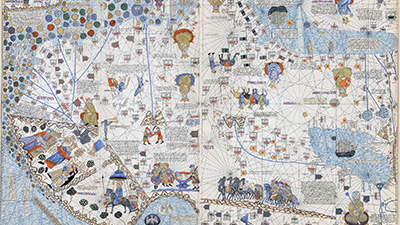Networks of Exchange
Teacher Resources
Driving Question: What were the causes and consequences of expanding networks of exchange from c. 1200 to 1450 CE?
Why start this course in 1200 CE? This provides important historical context for how the world was organized before it became globally connected. Learning about the variety of communities and networks that existed from 1200 to 1450 CE will also allow you to make historical comparisons across time and geographic space.
Learning Objectives:
- Explain how states interacted and exchanged culture, innovations, goods, and diseases through networks from c. 1200 to 1450 CE.
- Use the AP themes to evaluate networks of exchange from 1200 to 1450 CE
Vocab Terms:
- network
- society
- technology
- trade
- trade network
Opener: Networks of Exchange, c. 1200 to 1450 CE
To teach this lesson step, refer to page 2 of Lesson 2.0 Teaching Guide.
Use this Vocabulary Guide to learn about various vocabulary routines that go beyond memorization.
Want to connect to other WHP AP® World History teachers? Join the OER Project Community Forum.
What do you already know about key vocabulary in this unit? Test your knowledge!
Unit 2 Overview
To teach this lesson step, refer to page 3 of Lesson 2.0 Teaching Guide.
The development of ancient trade routes paved the way not only for economic development but also for cultural and political development as well.
-
Guiding Questions
-
Before you watch
As a reminder, skim the transcript and read the questions before viewing. Additionally, pause the video at important points.;
While you watch
- What are caravanserai and why were they useful?
- Where did large regional networks exist in this era?
- How was trade conducted over the largest network in Afro-Eurasia and what goods were traded along this route?
- How are the themes of governance and economic systems linked when studying networks of exchange in this era?
- How did the creation of the Mongol Empire disrupt trade but also lead to building new caravanserai?
- How did caravanserai affect many of the regions in which they were built?
After you watch
Respond to this question: Many of the things you use today come to you from far away. If you need proof, just look at the tags on your clothes or the “made in ____” labels on your pens or electronics. Using evidence from the video, what is one way that long-distance trade has changed since 1200 CE?
Key Ideas
Unit 2 Introduction: Networks of Exchange 1200 to 1450 CE
To teach this lesson step, refer to page 4 of Lesson 2.0 Teaching Guide.
Check out this blog for tips to help students to engage with text.
The Silk Roads allowed for much more than the trading of silk; in fact, it created superhighways of diffusion that spread new ideas, as well as new health concerns, far and wide.
-
Guiding Questions
-
Before you read
Preview the questions below, and then skim the article. Be sure to look at the section headings and any images.
While you read
Look for answers to these questions:
- What evidence does the author mention to challenge the narrative that European peasants had miserable lives?
- What is an artisan and where were the largest centers of artisan production in 1200 CE?
- How does the author explain the existence of the merchant occupation?
- What are the economic, cultural, and biological consequences of long-distance trade described by the author?
After you read
Respond to the following questions:
- The author opens this article by suggesting that life for European peasants wasn’t all that bad, in part because they had access to new trade goods. Do you think that access to new types of goods was always beneficial for the common people? Can you think of any types of goods that might have made life worse for some people?
- In Unit 1, you explored the diversity of the global tapestry from 1200 to 1450 CE. Unit 2 covers the same period, but focuses more on the way diverse regions were connected. After reading this article, do you think it is useful to study the world by dividing it into separate cultural or geographic regions? Why or why not?
Closer: Networks of Exchange, c. 1200 to 1450 CE
To teach this lesson step, refer to page 5 of Lesson 2.0 Teaching Guide.
Our Openers and Closers Guide will provide more information about these short, but important, activities at the beginning and end of each lesson.
Are you noticing a theme in this course? Of course, you are! That’s because AP Themes are evident throughout this course, and in your Themes Notebook, you will make those connections.



